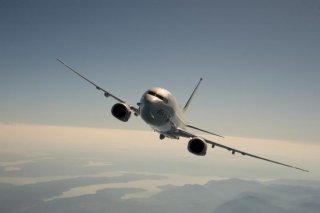Germany Is Buying This Plane to Kill Submarines - In the South China Sea?
Is Germany truly flexing its maritime muscles, or tacitly acknowledging Beijing’s claims in the South China Sea?
Here's What You Need to Remember: The proposed sale will allow Germany to modernize and sustain its Maritime Surveillance Aircraft (MSA) capability for the next 30 years. Germany will have no difficulty transitioning its MSA force to P-8 and absorbing these aircraft into its armed forces. The proposed sale of this equipment and support will not alter the basic military balance in the region.
A recent announcement from the Defense Security Cooperation Agency — responsible for equipping, training, and advising American overseas allies — cleared the way for the German government to acquire five P-8A Poseidon aircraft as well as associated P-8A support and training equipment. The deal is worth $1.77 billion.
The DSCA elaborated on the certification, saying “The proposed sale will improve Germany’s capability to meet current and future threats by providing critical capabilities to coalition maritime operations. Germany currently operates the Lockheed P-3C Orion, but that aircraft is reaching end-of-life and will retire in 2024. Germany plans to replace it with the P-8A Poseidon.
The proposed sale will allow Germany to modernize and sustain its Maritime Surveillance Aircraft (MSA) capability for the next 30 years. Germany will have no difficulty transitioning its MSA force to P-8 and absorbing these aircraft into its armed forces. The proposed sale of this equipment and support will not alter the basic military balance in the region.
The P-8 is a powerful multi-mission maritime patrol airplane that can conduct surveillance and reconnaissance missions, as well as search and rescue and anti-submarine warfare. The Boeing airframe is similar to the 737NG and share 86% commonality with the commercial airliner airframe, making it financially more economical to operate. Compared to its commercial counterpart, the P-8's airframe is strengthened for better low-altitude handling, and has two turbofan engines, whereas the older Orion has four turboprops.
Germany currently operates 8 P-3C Orions for maritime patrol and surveillance. The airframe design entered American service in the 1960s and has since grown long in the tooth. Berlin had previously examined overhauling and upgrading their Orions, though deemed the effort too costly and technically challenging to be feasible.
This recent acquisition comes on the heels of a freedom of navigation announcement by the German government, which plans to sail a German Navy frigate through the South China Sea later this summer. The area through which the German frigate would sail is claimed in large part by China but not recognized by the international community.
The German Navy has not sailed through the area since 2002, and the planned voyage has been hailed as a strong assertion of Germany’s commitment to international law. Significantly undercutting Berlin’s message, however, is the fact that ship will not pass within 12 nautical miles of islands claimed by China, in essence acknowledging Beijing’s claims to contested islands.
So despite Berlin upgrading their maritime patrol capability and planning an important freedom of navigation gesture, is Germany truly flexing its maritime muscles, or tacitly acknowledging Beijing’s claims in the South China Sea?
Caleb Larson is a Defense Writer with The National Interest. He holds a Master of Public Policy and covers U.S. and Russian security, European defense issues, and German politics and culture.
Image: Wikimedia

